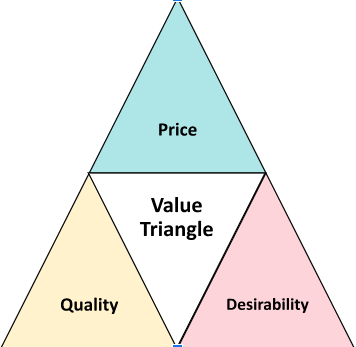Do you have a pricing strategy? If you’re anything like a lot of small business owners, you decide your price based on a set markup. If you spend X, you add 10% to the price. Some people just take a shot in the dark, hoping for a price that seems ‘reasonable.’
There’s no judgement here – pricing is hard!
Set prices too high, and you’ll miss out on valuable sales. Go too low, and you could be missing out on cash in the till. Somewhere between the two is the sweet spot – the ‘Goldilocks Zone.’
Finding this point is the reason all small business owners should use a competitive pricing strategy. Below, we’ll detail everything you need to know about pricing strategies, from key questions to ask to how to create one. And we’ll explain how something called a ‘value triangle’ might just hold the secret.
Let’s get started:
- What is a Pricing Strategy?
- Key Questions About Your Pricing Strategy
- What is the Value Triangle?
- Creating a Competitive Pricing Strategy
What is a Pricing Strategy?
Pick up a dusty economic textbook, and it will reliably inform you that price is determined by supply and demand. The more you have of something or the more people want it, the greater the price.
That’s nice in principle, but it doesn’t explain why the shop down the road sells the same product for £10 more or less.
Pricing, in practice, is a little more complicated. Your pricing strategy is a model or method used to help find the best price for your products. Moreover, it also includes your overall business strategy – for example, you could employ a ‘penetration pricing strategy’ if you’re entering a new market, slowly increasing the price over time. Or, if you see peaks and troughs in demand, a ‘dynamic pricing strategy’ could help you capitalise on these fluctuations – think of a hotel in peak or off-season.
Types of Pricing Strategies
Not sure which strategy is best for you? Here are 7 types of pricing strategies to consider:
- Competitive Pricing Strategy: Pricing products based on competitors’ prices, often lower, to gain an advantage.
- Example: Rental properties adjusting rates to match or beat competitor prices.
- Dynamic Pricing Strategy: Prices fluctuate based on market and demand factors.
- Example: Rideshare services adjusting rates during high-demand periods.
- Penetration Pricing Strategy: Introducing products at low prices, increasing them over time.
- Example: Streaming services offering low initial subscription rates.
- Economy Pricing Strategy: Setting low prices due to low production and marketing costs, aiming for high sales volume.
- Example: Airlines offering lower-priced economy seating.
- Premium Pricing Strategy: Deliberately high pricing to cultivate brand prestige.
- Example: Designer eyewear with premium pricing above competitors.
- Cost Plus Pricing Strategy: Adding a fixed markup on the product’s production cost.
- Example: Clothing brands markup garments by 50% from manufacturing costs.
Key Questions About Your Pricing Strategy
That’s the basics covered. Ask yourself these questions as you begin to formulate your strategy (especially if you’re at risk of under-pricing):
- Do similar products sell for more?
- Do you consider your hourly rate when pricing?
- Do you feel frustrated by your low income?
- Are your prices aligned with the perceived value of your product?
- How sensitive are your customers to price changes?
- Have you factored in all your overhead and indirect costs?
- How often do you review and adjust your pricing strategy?
- Do customers frequently comment on your prices being too high or too low?
- Have you considered seasonal demand fluctuations in your pricing?
Pricing is one part economic factors (expenses, unit cost, utilities, etc.) and another part perception. To justify your pricing, you need to communicate the value and desirability of your products. Share behind-the-scenes footage, elaborate on product elements, and tell your brand story.
Take Tony’s Chocolonely – as chocolate bars go, it’s among the most expensive bars on the supermarket shelf. How does it do so well? It promotes its eco-credentials and impeccable ingredients. Even the bar’s unevenly divided shape represents the unequal distribution of income in the chocolate industry. As the wrapper informs you, Tony’s is a 100% slavery-free treat.
Best of all, this branding didn’t cost them a penny extra – they’d have to shape the chocolate and print a wrapper anyway. It’s genius!
What is the Value Triangle?
Let’s talk about the value triangle! It consists of price, quality, and desirability. These three factors help you set your product prices.
First, there’s the quality – are you a value- or premium-level product? Premium products tend to receive a much higher price, though the business owners usually expect to sell less volume. Meanwhile, a value product should try to undercut as much of the market as possible while remaining profitable. If your product is handmade or organic, then the quality goes up (as does the desirability).
Next, desirability – the more sought-after your product, the greater the price. Think of desirability as a sort of artificial demand. People may purchase your product simply for the brand. For example, Ray-Ban sunglasses don’t cost any more to manufacture than a regular non-branded pair. However, the Ray-Ban label is highly desirable, boosting the price.
Finally, the result is your price – and that, in turn, determines the value. As a general rule, your perceived product value should be inversely proportional to the volume you sell. Put simply, the lower your perceived value, the more units you should sell. If you’ve got a product with a high value and a high sales volume, congratulations, you’re either extremely lucky or a business genius.
Creating a Competitive Pricing Strategy
Dealing with pricing concerns is intimidating – no doubt about it! Some simple tips include being as logical as possible and listening carefully to negative feedback. If a customer complains about the price, is it genuine, or do they like to complain? A single point of feedback is important, but real action only comes after consistent complaints. After all, you don’t want to alienate your numerous happy customers.
Follow these steps to create your perfect pricing strategy:
- Market Research: Conduct thorough research to identify key competitors, understand their pricing structures, and determine the average market price for similar products or services.
- Understand Your Costs: Calculate all costs associated with producing your product or service to ensure you’re pricing above your cost base, maintaining profitability.
- Determine Value Proposition: Identify what makes your product or service unique or better than competitors. This can justify a price point that’s higher, lower, or equivalent to the competition.
- Monitor and adjust Regularly: Keep a close eye on market trends, competitor price changes, and customer feedback. Adjust your prices as needed to stay competitive.
- Leverage Technology: Use pricing software or tools that allow for real-time price comparisons, helping you stay agile and responsive to market changes.
Don’t just set a price tag and be done. Pricing is as much about product development and evolution as the number itself. You can take many actions to boost (or earn) your price tag. Consider these ideas:
- Branding and packaging are major visual clues about your product’s price point. Sleek, minimalist designs with high-quality materials usually convey an expensive product. Shaping your customer’s perception ultimately informs the price they’re willing to pay.
- Prioritising minimal waste, sustainability, and minimalism in packaging not only creates a positive impression but can also justify a price premium for the environmentally-conscious consumer.
- Leveraging tactics such as limited editions, preordering, and FOMO (fear of missing out) can elevate a product’s desirability, allowing for potentially higher pricing due to heightened demand.
- Fast fashion brands have mastered the art of rapidly translating fashion trends into products, often in collaboration with influencers. This timely adaptation boosts perceived value and can allow for higher price points despite not always offering premium quality.
- Pricing should ensure adequate profitability to sustain business growth. Too narrow profit margins can be limiting; however, drastic price reductions may not always lead to the anticipated boost in sales.
Last, avoid keeping your prices the same for too long. Retailers need to be agile, adaptable, and responsive to market dynamics. That’s especially true at the time of writing due to the ongoing inflation crisis.
Closing Thoughts
Pricing strategies are a maze of decisions and ever-changing factors. For small businesses, it’s all too easy to put it in the back of your mind. If it ain’t broke, don’t fix it, right?
Except, sudden market fluctuations or consumer trends can leave your business walking on air. The prices you thought would last forever don’t. That’s why you need to maintain a competitive pricing strategy, using the value triangle as a guide. Find your ‘Goldilocks Zone,’ and work to keep yourself there – adjusting as necessary.
For more in-depth information on pricing, listen to ‘Pricing and Profitability in the Era of Rising Costs,’ episode #82 of The Resilient Retail Game Plan podcast. Here, Catherine Erdly takes a deep dive into pricing as small businesses feel the pinch.
Join the Club for more advice and one-on-one training – it’s the best resource for business owners looking to go to the next level!















